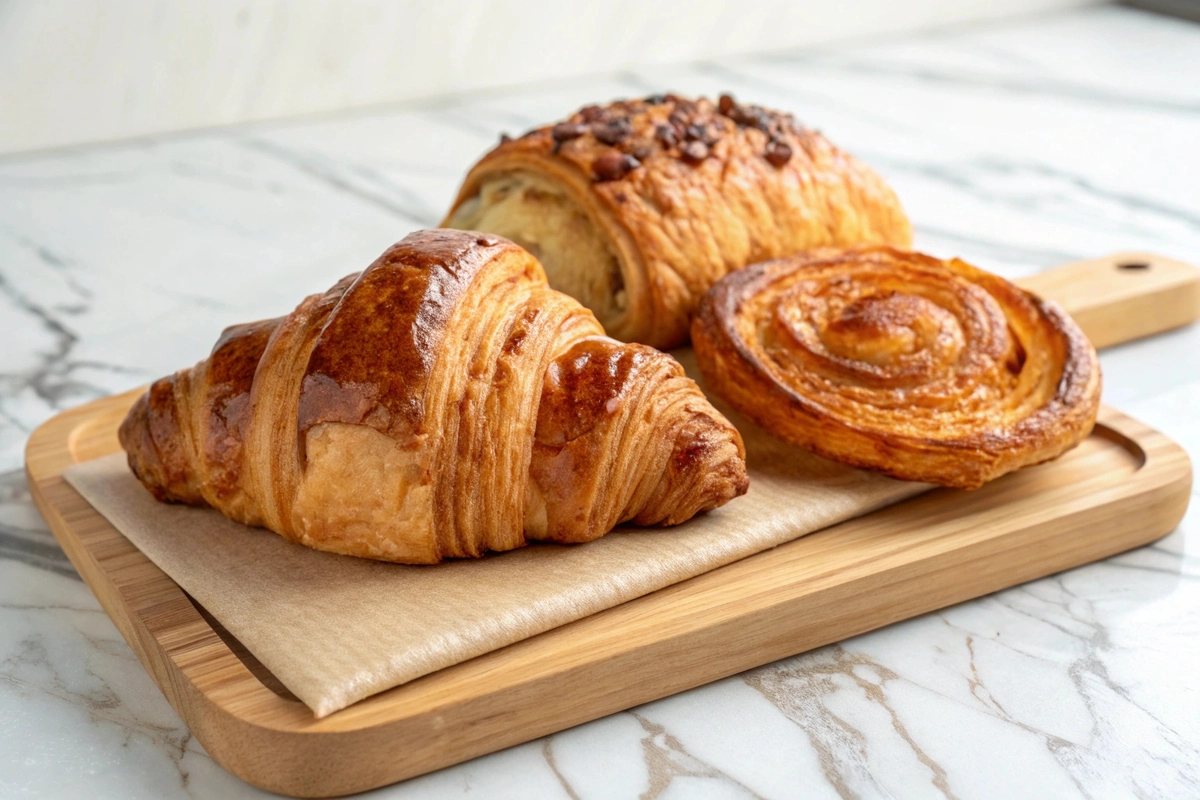The Ultimate Guide to Making an Authentic Gipfeli RecipeT
There’s nothing quite like the aroma of fresh-baked Gipfeli wafting through your kitchen in the morning. These Swiss crescent-shaped pastries are a must-try for any pastry lover—buttery, slightly sweet, and crisp on the outside with a soft, tender inside. If you’ve only had croissants, you’re in for a treat because Gipfeli has a charm of its own!
Whether you’re an experienced baker or a complete beginner, this ultimate guide will help you craft light, flaky Swiss Gipfeli at home. With step-by-step instructions, you’ll achieve bakery-quality results with ease. From the key ingredients to essential techniques, you’ll soon be crafting bakery-quality pastries with ease.
If you’re looking for another take on this Swiss classic, check out our flaky Swiss Gipfeli recipe for additional variations.
What Makes Gipfeli Special?
Many people assume Gipfeli and croissants are the same. While they look similar, they have distinct differences that set them apart.
- Less Butter, More Structure – Unlike croissants, Gipfeli contain less butter, making them slightly denser and easier to handle.
- Subtly Sweet Flavor – A touch more sugar gives them a mild sweetness, making them perfect for both sweet and savory fillings.
- Tighter, Compact Shape – Croissants have a looser, airier crumb, while Gipfeli holds their form with a more structured texture.
- Crisp Exterior, Soft Inside – The outer layers develop a delicate crunch, while the inside stays tender and pillowy.
If you love European pastries but want something a little less rich than a croissant, this homemade Swiss pastry might just become your new favorite.
Who Will Love This Gipfeli Recipe?
This recipe is perfect for:
✔️ Home bakers looking to master a new pastry skill.
✔️ Busy families who want a delicious make-ahead breakfast.
✔️ Brunch lovers searching for a show-stopping pastry.
✔️ Anyone who enjoys a balance of flaky and soft textures!
If that sounds like you, keep reading—you’ll soon discover the secrets to making perfectly flaky Gipfeli every time!

Mastering the Dough for the Perfect Gipfeli Recipe
The secret to a perfectly flaky and tender Gipfeli starts with the dough. It’s the foundation of this Swiss classic, and getting it right makes all the difference. While some pastries require complicated techniques, Gipfeli dough is surprisingly straightforward. With the right ingredients and a little patience, you’ll achieve bakery-level results with this easy Gipfeli recipe at home!
Pair your fresh Gipfeli with a side of these fluffy scrambled pancakes for a complete breakfast.
Essential Ingredients for Authentic Gipfeli
To create the ideal texture and flavor, every ingredient plays a crucial role. Here’s what you’ll need:
For the Dough:
- 3 ¼ cups (500g) bread flour – High-protein flour gives the dough structure.
- 1 tablespoon (12g) sugar – Adds a hint of sweetness without overpowering.
- 1 teaspoon (5g) salt – Balances flavor and strengthens gluten.
- 1 tablespoon (10g) active dry yeast – Helps the dough rise properly.
- ¾ cup (180ml) lukewarm milk – Activates the yeast and enriches the dough.
- 2 tablespoons (30g) unsalted butter, softened – Enhances flavor and tenderness.
- 1 egg, beaten (for egg wash) – Gives Gipfeli their signature golden crust.
For the Butter Layers (Lamination):
- ½ cup (115g) high-quality European butter – The key to delicate, flaky layers.
If you’re new to laminated dough, check out this step-by-step croissant dough guide for more details on butter layering techniques.
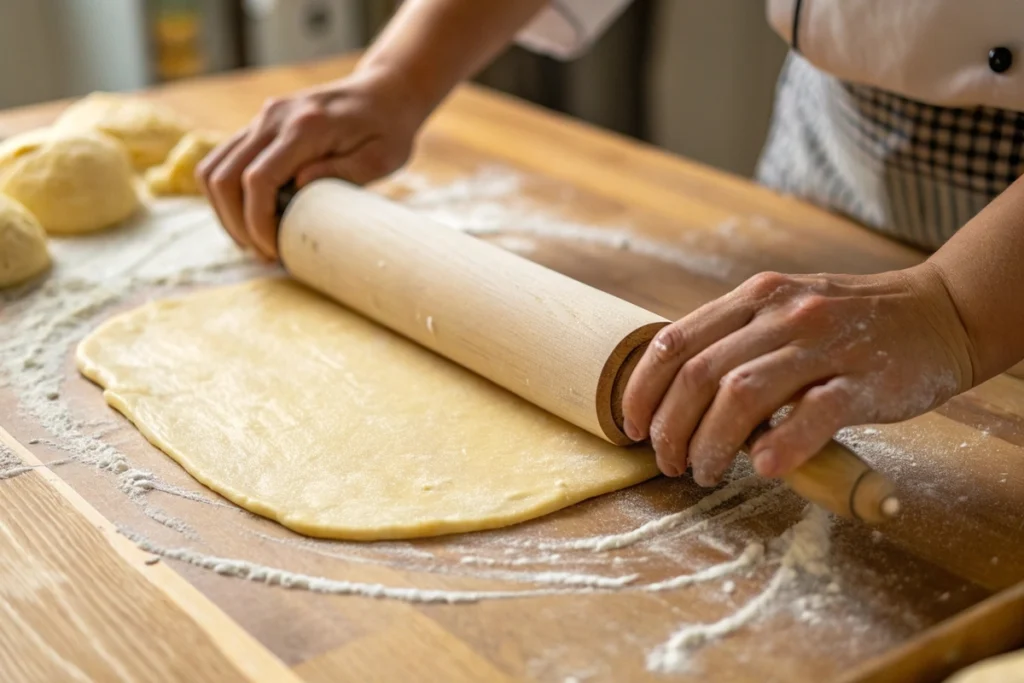
Step-by-Step Dough Preparation
1. Activate the Yeast
In a small bowl, combine lukewarm milk and yeast. Stir in a pinch of sugar, then let it sit for 10 minutes until it turns frothy. If nothing happens, your yeast may be inactive—start over with fresh yeast.
2. Mix the Dough
In a large mixing bowl, combine flour, sugar, and salt. Add the yeast mixture and mix until the dough starts coming together. Knead by hand or with a stand mixer fitted with a dough hook for 8–10 minutes, until smooth and slightly elastic.
3. First Rise (Bulk Fermentation)
Shape the dough into a ball, place it in a greased bowl, and cover with a kitchen towel. Let it rise at room temperature for about 1½ hours, or until it doubles in size. This slow rise develops flavor and improves texture.
4. Lamination: Folding in Butter for Layers
Now, it’s time to add the butter layers, which give this Swiss Gipfeli recipe its signature light, flaky texture.
How to Laminate Dough Like a Pro:
- Prepare the Butter Block – Place the butter between two sheets of parchment paper. Use a rolling pin to flatten it into a thin 6×6-inch square, then refrigerate for 20 minutes.
- Roll Out the Dough – Lightly flour a surface and roll the dough into a 12×12-inch square.
- Encasing the Butter – Place the chilled butter block in the center of the dough. Fold the edges over it like an envelope, sealing it completely.
- First Fold – Roll the dough into a 10×20-inch rectangle, then fold it into thirds (like folding a letter). Wrap in plastic and chill for 30 minutes.
- Second Fold – Repeat the rolling and folding process once more, then chill again for another 30 minutes.
This layering technique creates flaky, buttery layers that separate beautifully when baked.
5. Final Dough Rest
After the final chill, roll the dough into a large rectangle, about 4mm thick. Now it’s ready to be shaped into Gipfeli!
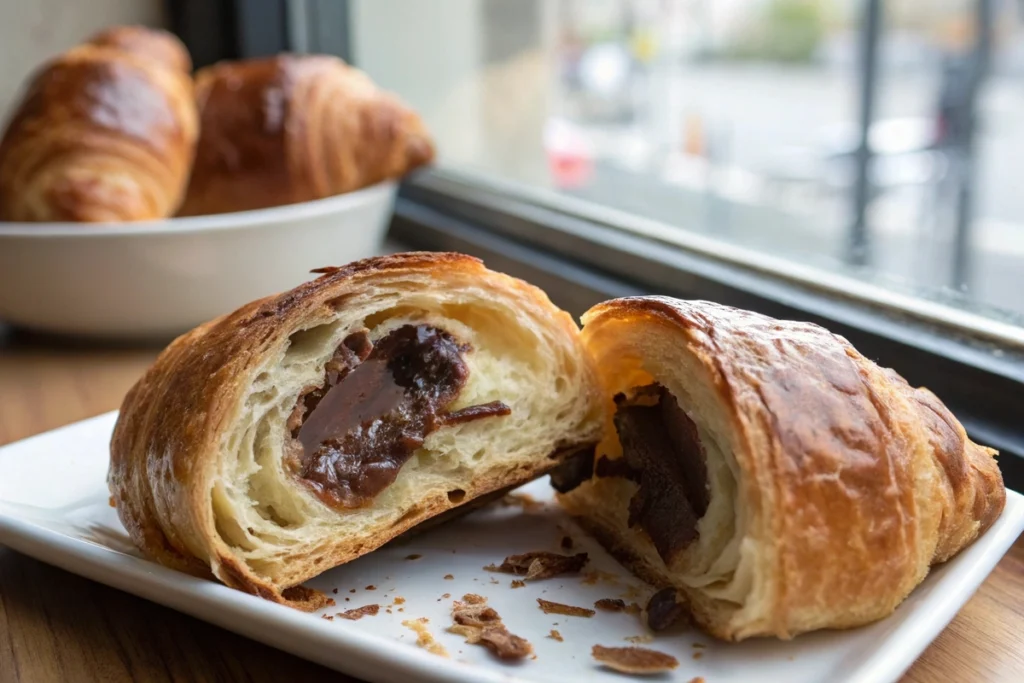
Pro Tips for a Flawless Dough
✔️ Use cold butter – This prevents it from melting into the dough too soon.
✔️ Don’t rush the chilling steps – Resting time allows gluten to relax, making the dough easier to roll.
✔️ Flour lightly – Too much flour can make the dough tough, so dust sparingly.
Now that you’ve mastered the dough, you’re ready to shape and bake perfect Gipfeli!
Shaping and Baking the Perfect Gipfeli Recipe
Now that your dough is laminated and well-rested, it’s time to shape and bake this classic Gipfeli recipe for a flaky, golden result. This step transforms your hard work into golden, flaky crescents that are light yet satisfyingly crisp. Follow these simple steps to ensure your Gipfeli turns out beautifully every time.
How to Shape Gipfeli Like a Pro
1. Roll Out the Dough
On a lightly floured surface, roll the chilled dough into a large rectangle, about 4mm thick. Keep the thickness even for consistent baking.
2. Cut into Triangles
Using a sharp knife or pizza cutter, divide the dough into long triangles about 3 inches wide at the base and 6 inches tall. This shape helps create the classic crescent roll look.
3. Roll the Dough
- Take one triangle and gently stretch the base to widen it slightly.
- Starting from the base, roll the dough tightly towards the tip.
- Place each rolled Gipfeli on a parchment-lined baking sheet, ensuring the tip is tucked under the roll to prevent unrolling during baking.
- If desired, curve the ends slightly to enhance the crescent shape.
4. Final Proofing
Cover the shaped Gipfeli loosely with a clean towel and let them rise at room temperature for 45–60 minutes. They should appear slightly puffy but not doubled in size.
Baking Instructions
1. Preheat the Oven
Set your oven to 400°F (200°C) and place a small oven-safe dish of water on the lower rack. This creates steam, resulting in a crisp exterior and tender interior.
2. Apply Egg Wash
Whisk one egg with 1 tablespoon of milk, then brush the tops of the Gipfeli gently with a pastry brush. This gives them a beautiful golden-brown finish.
3. Bake to Perfection
Place the tray in the center of the oven and bake for 15–18 minutes, or until the Gipfeli are deep golden brown and crisp.
4. Cool & Serve
Transfer the Gipfeli to a wire rack and let them cool for 10 minutes before serving. This allows the layers to set, enhancing their texture.
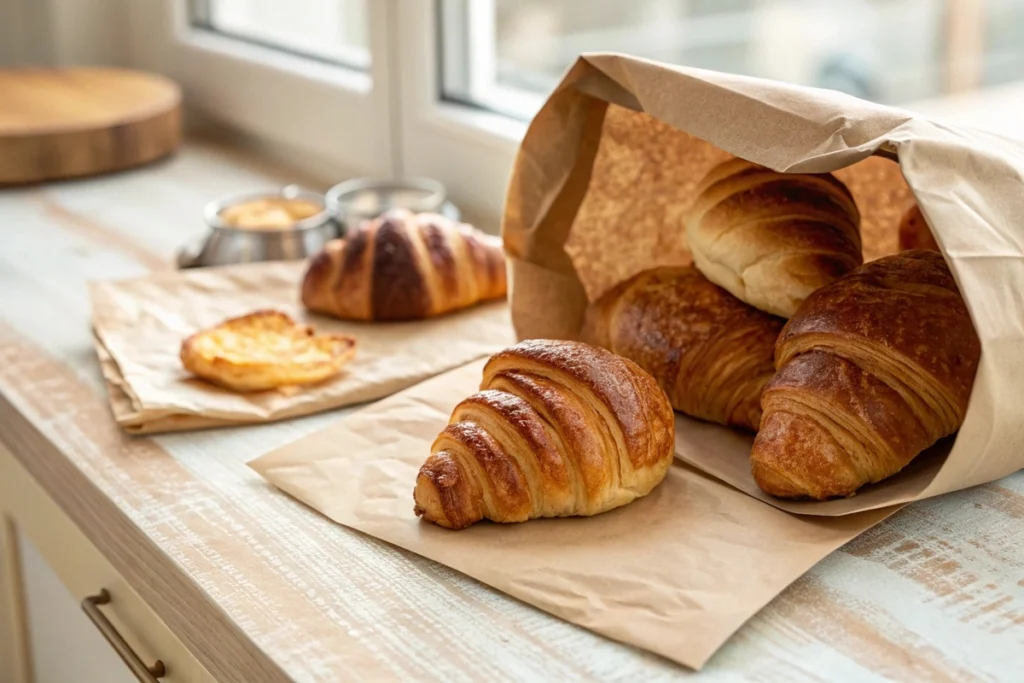
Nutrition Facts
| Serving Size | Calories | Carbohydrates | Protein | Fat |
|---|---|---|---|---|
| 1 Gipfeli | 210 kcal | 24g | 4g | 11g |
Note: Nutritional values are approximate and may vary based on ingredient brands and portion sizes.
Gipfeli is not overly rich but still provides a satisfying, buttery flavor. If you prefer a lighter version, consider using half whole wheat flour or reducing the butter slightly.
Pro Tips & Variations
✔️ For an Extra Crispy Finish – Let Gipfeli cool for 5 minutes, then return them to the warm oven (switched off) for 3 minutes.
✔️ Chocolate-Filled Variation – Before rolling, place one teaspoon of dark chocolate or Nutella at the base of each triangle.
✔️ Savory Twist – Add a sprinkle of grated Swiss cheese and fresh thyme inside before rolling for a delicious herby version.
✔️ Make-Ahead Tip – Freeze-shaped, unbaked Gipfeli on a baking sheet. When ready to bake, let them thaw and rise for 90 minutes, then follow the baking instructions.
- For more delicious laminated dough treats, explore our best puff pastry desserts to try new flavors.
Now that you’ve mastered the shaping and baking process, you’re ready to enjoy warm, homemade Swiss Gipfeli straight from the oven!
Common Mistakes & How to Fix Them
Even experienced bakers can run into issues when making Gipfeli. If your pastries aren’t coming out quite right, don’t worry! Here are the most common problems and how to fix them for perfect results every time.
1. My Gipfeli Dough Isn’t Rising
Problem: The dough stays dense and doesn’t puff up during proofing.
✔️ Fix: Ensure your yeast is active by dissolving it in warm (not hot) milk before mixing. The ideal temperature is 100–110°F (37–43°C). Also, let the doughproof in a warm, draft-free environment.
2. The Butter Leaks Out During Baking
Problem: Instead of forming flaky layers, the butter seeps out, making the Gipfeli greasy.
✔️ Fix: This happens when the butter is too warm or the dough isn’t chilled enough between folds. Always refrigerate the dough for at least 30 minutes after each fold and roll gently to prevent the butter from breaking through.
3. The Gipfeli Are Tough Instead of Flaky
Problem: The pastry is dense and chewy instead of crisp and tender.
✔️ Fix: Over-kneading the dough can cause too much gluten formation, making it tough. Knead just until smooth, and always handle the dough lightly when folding.
4. My Gipfeli Burn Before They Are Fully Baked
Problem: The tops get too dark while the inside remains undercooked.
✔️ Fix: Your oven may be too hot, or the pastries might be placed too close to the heating element. Bake at 400°F (200°C) on the middle rack, and if necessary, cover the tops with foil during the last few minutes of baking.
5. The Layers Didn’t Separate Properly
Problem: The inside of the Gipfeli feels doughy rather than light and airy.
✔️ Fix: This is often due to rolling the dough too thin or skipping the resting time between folds. Ensure you let the dough rest and chill properly to allow the butter layers to set.
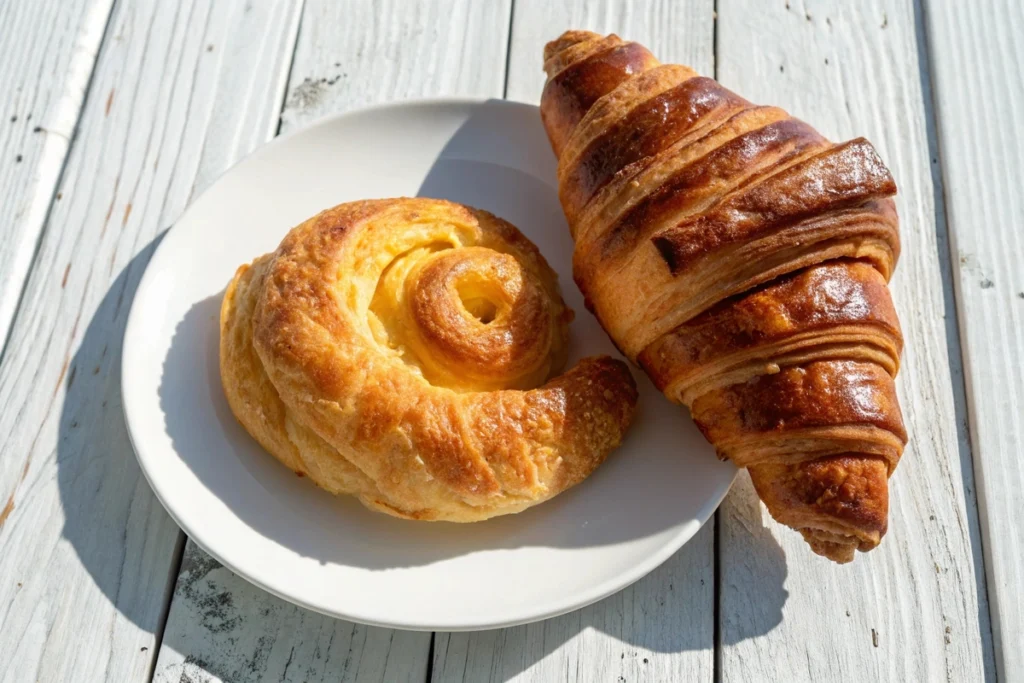
FAQ
What is the difference between croissants and Gipfeli?
While both are crescent-shaped pastries, Gipfeli is less buttery, slightly denser, and has a mild sweetness. Croissants, on the other hand, are ultra-flaky due to additional butter layers. Gipfeli also holds their shape better and have a firmer bite, making them ideal for both sweet and savory variations.
What are the ingredients in croissant dough?
Traditional croissant dough consists of flour, water, milk, sugar, salt, yeast, and a large amount of butter for lamination. The layering process creates an airy, delicate structure that makes croissants so light and flaky. Unlike Gipfeli, croissant dough relies on more butter and a lengthier folding technique.
What is a croissant made of?
A croissant is made from laminated dough, which involves folding and rolling layers of butter between thin sheets of yeast-leavened dough. This process creates hundreds of paper-thin layers that puff up when baked, resulting in the signature crispy, flaky texture. Croissants can be enjoyed plain or filled with chocolate, almond paste, or ham and cheese.
Can I make a Gipfeli recipe without butter?
Yes, but the texture will change significantly. While traditional Gipfeli requires butter for flakiness, you can substitute with plant-based margarine for a dairy-free version. Keep in mind that European-style butter is preferred for its lower water content, which helps create the best layers and texture.
Enjoy Your Homemade Gipfeli Today
Now that you’ve mastered this authentic Swiss Gipfeli recipe, you’re ready to bake like a pro! With its perfect balance of flaky layers and a tender interior, Gipfeli makes an excellent addition to any breakfast, brunch, or afternoon treat. Whether you prefer the classic butter version, chocolate-filled delight, or a savory cheese and herb twist, there’s a variation for everyone.
If you’ve tried this recipe, let us know how it turned out! Feel free to explore more delicious pastry recipes or ask any baking-related questions in the comments. Happy baking!
If you love pastries, why not try a twist on a classic with these cinnamon roll pancakes for a sweet breakfast treat?

